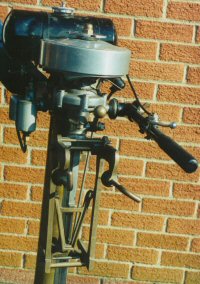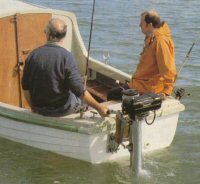 |
|

| |
The History of British Seagull Outboards
Just how many British Seagull outboard engines are in sheds, garages and outhouses?
The original design was one of many initiated by the original manufacturers, John Marston Ltd and the Sunbeam Motor Company, the makers of the famous Sunbeam motorcycles. We do, however, understand that the design was developed as a marine engine rather than an adapted industrial engine. This is probably one of the major reasons for their endurance and success.
By 1931 the first Seagulls, sold as the Marston Seagull, were in full production, these were much the same in design as the more modern engines and incorporated innovative ideas such as reverse gears and water-cooled exhausts. The engines were available in both short and long shaft and the models ranged from the Standard and the High Power through to the Super High Power. This engine was a twin cylinder 10hp version capable of powering boats up to 30 feet (9.1m).
 The two men credited with the continued development of the Seagull engine are John Way-Hope, who had worked for Evinrude, and Bill Pinniger, a design engineer. They met while working in the marine division of the Sunbeam Motor Company. After acquiring the manufacturing rights and patents for the Marston Seagull engines they set up the Bristol Motor Company in Bristol and financed the purchase of those patents with dealings in light aircraft and expensive sports cars. By 1938 they had consolidated the design of the engine and had moved into new premises on the Quay at Poole, Dorset. To celebrate this milestone the name Marston Seagull was changed to British Seagull and the engine was proclaimed as 'The Best Outboard Motor in the World' - later changed to 'The Best Outboard Motor for the World'.
The two men credited with the continued development of the Seagull engine are John Way-Hope, who had worked for Evinrude, and Bill Pinniger, a design engineer. They met while working in the marine division of the Sunbeam Motor Company. After acquiring the manufacturing rights and patents for the Marston Seagull engines they set up the Bristol Motor Company in Bristol and financed the purchase of those patents with dealings in light aircraft and expensive sports cars. By 1938 they had consolidated the design of the engine and had moved into new premises on the Quay at Poole, Dorset. To celebrate this milestone the name Marston Seagull was changed to British Seagull and the engine was proclaimed as 'The Best Outboard Motor in the World' - later changed to 'The Best Outboard Motor for the World'.
At this time they cut the range to one engine, reverse gears were dispensed with as Way-Hope considered them as 'a rather sissy refinement, rendered superfluous by efficient boat handling'. However, their patented 'Positive and Self-Adjusting Free-Engine Clutch' was considered by them to be so near perfection that no serious alteration to the 1938 design was contemplated until the mid-1960s. Way-Hope and Pinniger's concept was to use the best materials possible for the punishing marine environment.
We believe the Admiralty's request for a 'rough and ready' version of the '102' for use on light assault craft help to establish the company. The engine needed little alteration; the Navy required an engine that would run non-stop for 24 hours. This wartime success developed the next batch of engines, the 40 Minus in 1949, the 40 Plus in 1952 and the Century and Century Plus by 1955/56. As each engine was designed a number of prototypes were produced, some over many years, fishermen and company members tested all these in 'real life' situations. This together with their 'concept of power output' meant that this established Seagull's worldwide reputation as a no-nonsense design suitable for extremes of climate from the Antarctic to tropical heat and also able to sustain considerable user abuse and total immersion.
By the mid 1950s British Seagull had moved to new premises at Fleets Bridge, Poole where they reached their all-time peak during the 1960s. At this time everything except the gears and the carburettors were made on site.
 In 1982 British Seagull moved again to premises at Newtown Business Park, Poole and launched the large 7.5hp Model 170. This engine featured an engine cover and was the forerunner of the QB Series. The QB Series was introduced at the 1987 London Boat Show with the 6hp Kingfisher; soon followed by the 5hp Osprey and the 4hp Curlew. This design represented the very latest in two-stroke technology in conjunction with Queens University, Belfast who are regarded as one of the world's leaders in innovative engine research.
In 1982 British Seagull moved again to premises at Newtown Business Park, Poole and launched the large 7.5hp Model 170. This engine featured an engine cover and was the forerunner of the QB Series. The QB Series was introduced at the 1987 London Boat Show with the 6hp Kingfisher; soon followed by the 5hp Osprey and the 4hp Curlew. This design represented the very latest in two-stroke technology in conjunction with Queens University, Belfast who are regarded as one of the world's leaders in innovative engine research.
In 1996 the production of the British Seagull outboard engines ceased but the Spare Parts supply continued in its renowned friendly and highly personal way. In 1999, Chillington Marine Ltd, the owners at that time of British Seagull decided to pull out of the marine leisure market handing over responsibility for the British Seagull name to Sheridan Marine on the River Thames in Oxfordshire. We have continued the manufacture and supply, where possible, of original spare parts re-introducing some discontinued items in the last few years.
We take the continuity of the British Seagull name seriously and intend to fly the flag proudly well into this Millennium.
|
|
|
